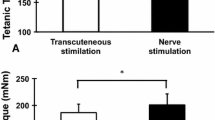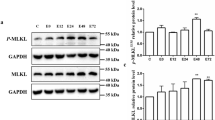Abstract
This study investigated the injured region-specific alterations of factors related to the “repeated bout effect” (RBE), i.e., when the first bout of eccentric exercise generates resistance to injuries from the second bout of the same exercise. Wistar rats were divided into single injury (SI) and repeated injury (RI) groups. The right gastrocnemius muscle was subjected to a bout of eccentric contractions (ECs) at the age of 14 weeks in the SI group and 10 and 14 weeks in the RI group. The number of injured fibers after the last bout of ECs was lower in RI than in SI. In the SI group, injured fibers after ECs were mainly located in the superficial region of muscle and expressed myosin heavy chain (MHC) IIx and IIb. Prior to the second bout of ECs, the fiber-type composition in the RI group showed decreased MHC IIx and IIb fibers and increased MHC IIa fibers compared with those in the SI group. However, most regenerating fibers showed either MHC IIx or IIb expression. Heat shock protein 72 and total collagen contents in whole muscle were higher in the RI group than in the SI group; however, only the collagen expression in the RI group was more intense than that in the SI group in the superficial region of muscle. These findings suggest that increased collagen may play a more important role in the injured region of muscle than the other factors in RBE.





Similar content being viewed by others
References
Baoge L, Van Den Steen E, Rimbaut S et al (2012) Treatment of skeletal muscle injury: a review. ISRN Orthop [Internet]. Available from: http://www.hindawi.com/journals/isrn/2012/689012/. doi:10.5402/2012/689012
Barbier J, Popoff MR, Molgó J (2004) Degeneration and regeneration of murine skeletal neuromuscular junctions after intramuscular injection with a sublethal dose of Clostridium sordellii lethal toxin. Infect Immun 72(6):3120–3128
Bobbert MF, Hollander AP, Huijing PA (1986) Factors in delayed onset muscular soreness of man. Med Sci Sports Exerc 18(1):75–81
Boppart MD, Burkin DJ, Kaufman SJ (2006) Alpha7beta1-integrin regulates mechanotransduction and prevents skeletal muscle injury. Am J Phys Cell Physiol 290(6):1660–1665
Butterfield TA, Herzog W (2006) The magnitude of muscle strain does not influence serial sarcomere number adaptations following eccentric exercise. Pflugers Arch 451(5):688–700
Byrnes WC, Clarkson PM, White JS, Hsieh SS, Frykman PN, Maughan RJ (1985) Delayed onset muscle soreness following repeated bouts of downhill running. J Appl Physiol 59(3):710–715
Clarkson PM, Nosaka K, Braun B (1992) Muscle function after exercise-induced muscle damage and rapid adaptation. Med Sci Sports Exerc 24(5):512–520
Feit H, Kawai M, Mostafapour AS (1989) The role of collagen crosslinking in the increased stiffness of avian dystrophic muscle. Muscle Nerve 12:486–492
Howatson G, van Someren KA (2008) The prevention and treatment of exercise-induced muscle damage. Sports Med 38(6):483–503
Huard J, Li Y, Fu FH (2002) Muscle injuries and repair: current trends in research. J Bone Joint Surg Am 84-A(5):822–832
Hyldahl RD, Nelson B, Xin L, et al. (2015) Extracellular matrix remodeling and its contribution to protective adaptation following lengthening contractions in human muscle. FASEB J 29(7):2894–2904
Kasuga N, Ishido M, Suzuki H, Yuki A (2010) Characteristic of muscle fiber after type transformation. Bull Aichi Univ Educ 59:35–41
Kovanen V, Suominen H, Heikkinen E (1984) Collagen of slow and fast twitch muscle fibres in different types of rat skeletal muscle. Eur J Appl Physiol Occup Physiol 52(2):235–242
Lapier TK, Burton HW, Almon R, Cerny F (1985) Alterations in intramuscular connective tissue after limb casting affect contraction-induced muscle injury. J Appl Physiol 78:1065–1069
Lieber RL, Fridén J (1988) Selective damage of fast glycolytic muscle fibers with eccentric contraction of the rabbit tibialis anterior. Acta Physiol Scand 133:587–588
Lieber RL, Ward SR (2013) Cellular mechanisms of tissue fibrosis. 4. Structural and functional consequences of skeletal muscle fibrosis. Am J Phys Cell Physiol 305(3):C241–C252
Lieber RL, Woodburn TM, Fridén J (1991) Muscle damage induced by eccentric contractions of 25 % strain. J Appl Physiol 70:2498–2507
Lima LC, Denadai BS (2015) Attenuation of eccentric exercise-induced muscle damage conferred by maximal isometric contractions: a mini review. Front Physiol 6:300
Liu CC, Lin CH, Lin CY, Lee CC, Lin MT, Wen HC (2013) Transgenic overexpression of heat shock protein 72 in mouse muscle protects against exhaustive exercise-induced skeletal muscle damage. J Formos Med Assoc 112(1):24–30
López B, Querejeta R, González A, Larman M, Díez J (2012) Collagen cross-linking but not collagen amount associates with elevated filling pressures in hypertensive patients with stage C heart failure: potential role of lysyl oxidase. Hypertension 60(3):677–683
Lovering RM, De Deyne PG (2004) Contractile function, sarcolemma integrity, and the loss of dystrophin after skeletal muscle eccentric contraction-induced injury. Am J Phys Cell Physiol 286:C230–C238
Lovering RM, Roche JA, Bloch RJ, De Deyne PG (2007) Recovery of function in skeletal muscle following 2 different contraction-induced injuries. Arch Phys Med Rehabil 88:617–625
Margaritelis NV, Theodorou AA, Baltzopoulos V, Maganaris CN, Paschalis V, Kyparos A, Nikolaidis MG (2015) Muscle damage and inflammation after eccentric exercise: can the repeated bout effect be removed? Physiol Rep [Internet]. Available from: http://www.ncbi.nlm.nih.gov/pubmed/26660557. doi:10.14814/phy2.12648
Matsuura T, Li Y, Giacobino JP, Fu FH, Huard J (2007) Skeletal muscle fiber type conversion during the repair of mouse soleus: potential implications for muscle healing after injury. J Orthop Res 25(11):1534–1540
McHugh MP (2003) Recent advances in the understanding of the repeated bout effect: the protective effect against muscle damage from a single bout of eccentric exercise. Scand J Med Sci Sports 13(2):88–97
McHugh MP, Connolly DA, Eston RG, Gleim GW (1999) Exercise-induced muscle damage and potential mechanisms for the repeated bout effect. Sports Med 27(3):157–170
Nosaka K (2011) Exercise-induced muscle damage and delayed onset muscle soreness. In: Cardinale M, Newton R, Nosaka K (eds) Strength and conditioning: biological principles and practical applications. Wiley-Blackwell, Chichester, pp. 179–192
Nosaka K, Sakamoto K, Newton M, Sacco P (2001) The repeated bout effect of reduced-load eccentric exercise on elbow flexor muscle damage. Eur J Appl Physiol 85(1–2):34–40
Ochi E, Nakazato K, Ishii N (2007) Effects of eccentric exercise on joint stiffness and muscle connectin (titin) isoform in the rat hindlimb. J Physiol Sci 57(1):1–6
Ochi E, Nakazato K, Song H, Nakajima H (2008) Aging effects on passive resistive torque in the rat ankle joint after lengthening contractions. J Orthop Sci 13:218–224
Oishi Y, Ishihara A, Ifuku H, Taniguchi K, Matsumoto H (1998) Fiber type specific distribution of stress proteins in rat skeletal muscle. Tairyoku kagaku 47(1):87–92
Salvini TF, Morini CC, Selistre de Araújo HS, Ownby CL (1999) Long-term regeneration of fast and slow murine skeletal muscles after injury by ACL myotoxin isolated from Agkistrodon contortrix laticinctus (broad-banded copperhead) venom. Anat Rec 254(4):521–533
Shima Y, Kitaoka K, Yoshiki Y, Maruhashi Y, Tsuyama T, Tomita K (2008) Effect of heat shock preconditioning on ROS scavenging activity in rat skeletal muscle after downhill running. J Physiol Sci 58(5):341–348
Smith LR, Fowler-Gerace LH, Lieber RL (2011) Muscle extracellular matrix applies a transverse stress on fibers with axial strain. J Biomech 44(8):1618–1620
Song H, Nakazato K, Nakajima H (2004) Effect of increased excursion of the ankle on the severity of acute eccentric contraction-induced strain injury in the gastrocnemius: an in vivo rat study. Am J Sports Med 32:1263–1269
Takagi R, Fujita N, Arakawa T, Kawada S, Ishii N, Miki A (2011) Influence of icing on muscle regeneration after crush injury to skeletal muscles in rats. J Appl Physiol 110(2):382–388
Thorsteinsdóttir S, Deries M, Cachaço AS, Bajanca F (2011) The extracellular matrix dimension of skeletal muscle development. Dev Biol 354(2):191–207
Tsutaki A, Ogasawara R, Kobayashi K, Lee K, Kouzaki K, Nakazato K (2013) Effect of intermittent low-frequency electrical stimulation on the rat gastrocnemius muscle. Biomed Res Int [Internet]. Available from: http://www.hindawi.com/journals/bmri/2013/480620/. doi:10.1155/2013/480620
Welinder C, Ekblad L (2011) Coomassie staining as loading control in Western blot analysis. J Proteome Res 10:1416–1419
Yoseph B, Soker S (2015) Redefining the satellite cell as the motor of skeletal muscle regeneration. JSAB 5(1):76–82
Acknowledgments
This study was supported by a Grant-in-Aid for Scientific Research (B) from the Japan Society for the Promotion of Science (no. 15H03078). The authors declare no conflicts of interest and that the results of this study are presented clearly, honestly, and without fabrication, falsification, or inappropriate data manipulation. The results of the present study do not constitute endorsement by the Federation of European Physiological Societies.
Author information
Authors and Affiliations
Corresponding author
Ethics declarations
This study was approved by the ethical committee of the Nippon Sport Science University (no. 014-A03).
Rights and permissions
About this article
Cite this article
Takagi, R., Ogasawara, R., Tsutaki, A. et al. Regional adaptation of collagen in skeletal muscle to repeated bouts of strenuous eccentric exercise. Pflugers Arch - Eur J Physiol 468, 1565–1572 (2016). https://doi.org/10.1007/s00424-016-1860-3
Received:
Revised:
Accepted:
Published:
Issue Date:
DOI: https://doi.org/10.1007/s00424-016-1860-3




